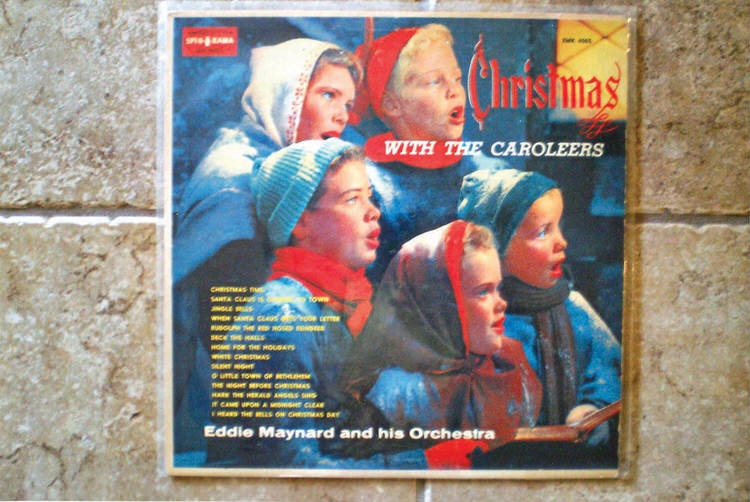
From about 1949 into the 1980s, it wasn’t uncommon to see racks of cheap, anonymous Christmas records in your local drugstore.
Robert Hover
For those of you out there who love and collect those older, budget label Christmas records, the kind your parents randomly purchased at the local drugstore or five and 10 cent store as something different to play on the home stereo during the holidays, do I have a ton of pure Cheez Whiz to share with you.
From about 1949 and well into the 1980s, it wasn’t uncommon to see racks of super-cheap (inexpensive), anonymous Christmas records in your local Bartell Drug store, IGA Supermarket, or Fred Meyer store, selling from 88 cents to $1.98. They were a cheap, “impulse” thing you bought when your Christmas spirit was at its all-time high, even if money was tight. This made an even balance. You’ve got your gifts and gift wrap, new ornaments and lights for the tree, a fifth of cheap rum or whiskey and a quart of eggnog for the ritual Tom and Jerrys; then you remember that you’ve got to have seasonal tunes.
And there they were, conveniently displayed near the store’s check-out stands for insanely rock-bottom prices. Granted, it was “mystery” music by unknown singers, orchestras, and vocal groups, but who knew and cared. Problem solved.
Sometimes these records became family heirlooms, others were later donated to thrift stores or sold at garage sales, but there’s a soft spot for those over 50 who can still remember seeing these holiday records on display in stores.
First, let’s get started with the most common budget label act that is absolutely mandatory in any collection of cheapo Christmas vinyl: The Caroleers. The Caroleers weren’t technically an actual group, although some Caroleers tracks have the same vocalists. It appears to be the generic umbrella name for anonymous holiday material from the Synthetic Plastics Company in Newark, N.J., which was famous for their Peter Pan label, cheapo kiddie records and their various subsidiary labels, regardless of the actual performer. Many of the same songs appear on several different Caroleers LPs on various budget labels, but not only on LPs, also 45 RPM singles and 45 RPM Extended Plays in the 1950s and 1960s that usually featured gorgeous picture sleeves. Note: The Caroleers even featured a lead singer named Dick Edwards, who was a dead-on Perry Como sound-alike.
Putting names and faces to this music is next to impossible. SPC/Peter Pan (as well as with the many other budget labels) only paid their studio performers a flat rate with no future royalties, and they rarely listed credits for anyone. However, I found one actual person who not only appeared on some Caroleers tracks but could very well be the mysterious, female-sounding voice on the Christmas novelty tune “Nuttin’ for Christmas” that was credited to a “Bobby Stewart” on Peter Pan records.
Her name was Toby Deane, a comedienne and voice actress. Toby Deane recorded for the SPC/Peter Pan label records from the 1950s to the 1970s. Her voice is believed to be on several hundred children’s records, as with Anne Lloyd of Little Golden Records fame. Then there’s Eddie Maynard and his orchestra. All that is known about Eddie Maynard’s orchestra is that they appear on LPs credited to The Caroleers.
With the release of the album Santa Claus Is Coming to Town on the Diplomat/Tinkerbell label in 1970, the sound of The Caroleers radically changed, and re-issued tracks from the past were not recycled. Here, for the first time, a Caroleers LP was of mostly original material, sung by Toby Deane and Ray Dorey, a pop singer, who, like Toby Deane, performed with Benny Goodman’s orchestra in the 1940s. Ray Dorey was also a performer in the Boston area on radio and television in the 1950s, and in later years, he recorded children’s records and other material for SPC/Peter Pan.
This 1970s Christmas album sound was more cohesive than the other Caroleers Christmas albums, in that it wasn’t a grab bag of whatever was in the SPC/Peter Pan vaults, and that it was recorded by a single group in a session specifically for this album.
Toby Deane also appears on the LP Christmas Is for Children—Merry Favorites from Santa’s Little Helpers, released on Design records in 1957. In fact, many of The Caroleers vocalists from the SPC/Peter Pan labels appear on the Pickwick distributed album. It appears there were no exclusive contracts to the budget labels, as these performers seemed to appear on nearly all of them. The cheapo Design label was Pickwick’s subsidiary label.
